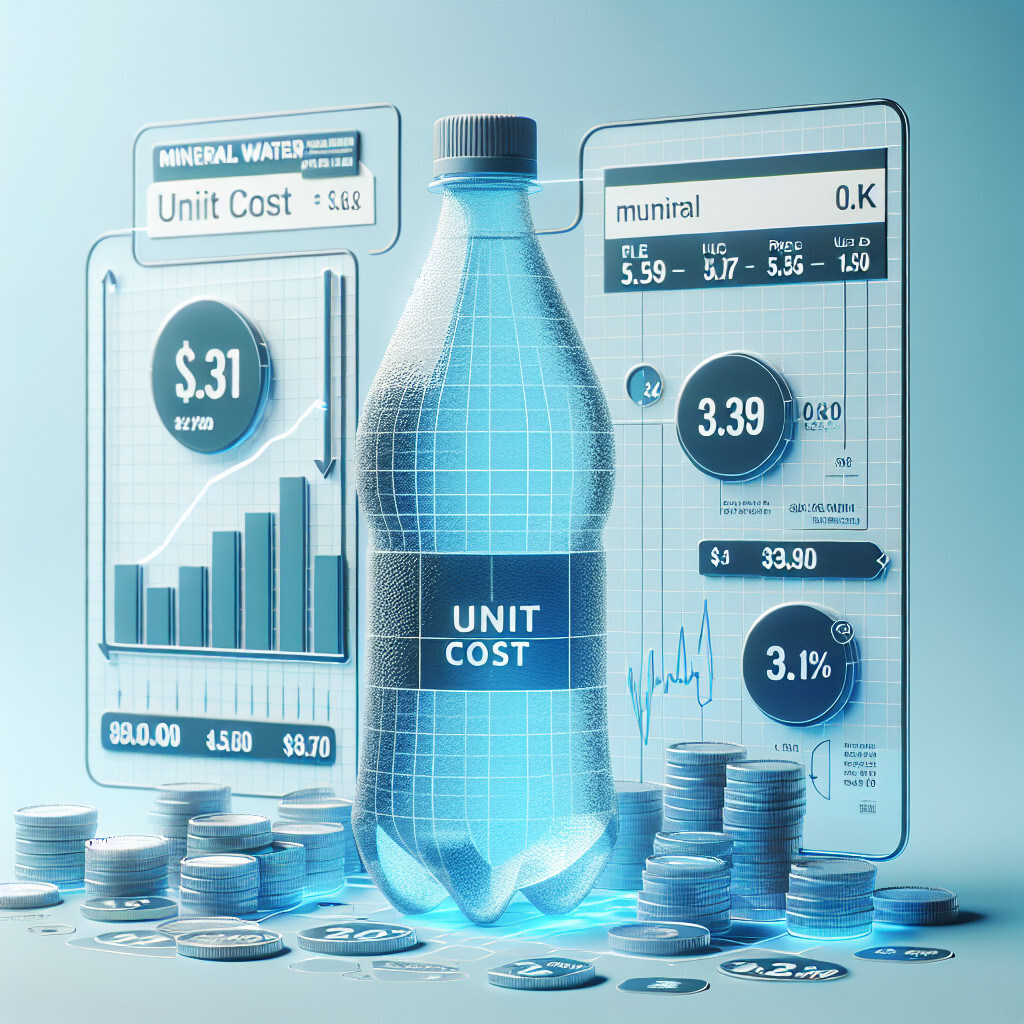-
Table of Contents
“Affordable Purity in Every Drop”
Introduction

The mineral water unit cost refers to the expense incurred in the production, packaging, and distribution of a single unit of bottled mineral water. This cost includes various factors such as the extraction of water, filtration processes, bottling, labeling, quality control, and transportation. The unit cost can vary significantly depending on the source of the water, the purification process used, the type of packaging, and the location of the market. It is a critical factor in determining the retail price and profitability of mineral water products.
Understanding the Factors Influencing Mineral Water Unit Cost
Mineral water, a vital commodity in our daily lives, is often taken for granted. However, the process of bringing this essential resource from its natural source to our homes and offices is complex and involves various factors that influence its unit cost. Understanding these factors can provide valuable insights into the pricing structure of mineral water and help consumers make informed decisions.
The first factor that significantly impacts the unit cost of mineral water is the source. Mineral water is typically derived from natural springs, which are not uniformly distributed across the globe. The proximity of the source to the bottling plant and the market significantly influences transportation costs. If the source is located in a remote area, the cost of extracting and transporting the water to the bottling plant increases, which in turn raises the unit cost.
The quality of the source water also plays a crucial role in determining the unit cost. If the water is of high quality and requires minimal treatment, the production costs are lower. However, if the water needs extensive purification and mineral enrichment, the production costs rise, leading to a higher unit cost.
The production process itself is another significant factor. The process of bottling mineral water involves several stages, including extraction, purification, mineral enrichment, bottling, and packaging. Each of these stages incurs costs in terms of machinery, labor, energy, and materials. The more complex the process, the higher the production costs, which directly impacts the unit cost of the mineral water.
Regulatory compliance is another factor that influences the unit cost. Mineral water producers must adhere to stringent health and safety regulations to ensure the quality and safety of their products. These regulations often require significant investments in quality control, testing, and certification, which add to the overall production costs.
The scale of production also plays a role in determining the unit cost. Larger producers can take advantage of economies of scale, which allows them to spread their fixed costs over a larger volume of production, thereby reducing the unit cost. Smaller producers, on the other hand, may have higher unit costs due to their lower production volumes.
Marketing and distribution costs also contribute to the unit cost of mineral water. These include the costs of advertising, branding, and distributing the product to retailers and consumers. The more a company spends on these activities, the higher the unit cost of its mineral water.
Lastly, the pricing strategy of the company can influence the unit cost. Some companies may choose to price their products higher to position them as premium products, while others may opt for a lower price to attract cost-conscious consumers.
In conclusion, the unit cost of mineral water is influenced by a multitude of factors, ranging from the source and quality of the water to the production process, regulatory compliance, scale of production, marketing and distribution costs, and the company’s pricing strategy. Understanding these factors can help consumers make more informed decisions when purchasing mineral water.
The Economics Behind Mineral Water Production: A Focus on Unit Cost
Mineral water, a staple commodity in our daily lives, is often taken for granted without much thought given to its production process. However, the economics behind mineral water production, particularly the unit cost, is a fascinating subject that deserves attention. The unit cost of mineral water production is a critical factor that determines the price at which it is sold to consumers. It is influenced by a myriad of factors, including the cost of raw materials, labor, energy, and transportation, among others.
The production of mineral water begins with the extraction of water from natural sources. This water is then subjected to a series of purification processes to remove impurities and harmful substances. The cost of these processes, which include filtration, disinfection, and mineral addition, forms a significant part of the unit cost. The cost of raw materials, such as the water itself, the minerals added, and the packaging materials, also contribute to the unit cost.
Labor costs are another significant component of the unit cost. The production of mineral water involves various stages, each requiring skilled labor. From the extraction of water to its purification and packaging, each stage requires a different set of skills. The cost of hiring and training these workers, as well as their wages, forms a substantial part of the unit cost.
Energy costs are another crucial factor. The production of mineral water is an energy-intensive process. The extraction, purification, and packaging processes all require significant amounts of energy. The cost of this energy, whether it comes from electricity, gas, or other sources, is a significant contributor to the unit cost.
Transportation costs also play a significant role in determining the unit cost. Once the mineral water is packaged, it needs to be transported to various distribution points, from where it is sold to consumers. The cost of this transportation, which includes fuel and vehicle maintenance costs, adds to the unit cost.
In addition to these direct costs, there are also indirect costs that contribute to the unit cost. These include the cost of maintaining the production facilities, the cost of quality control and assurance processes, and the cost of marketing and advertising. These costs, while not directly related to the production process, are essential for the successful operation of a mineral water production business.
The unit cost of mineral water production is also influenced by external factors such as government regulations and market competition. Government regulations often require mineral water producers to meet certain quality standards, which can increase the cost of production. Market competition, on the other hand, can drive down the unit cost as producers strive to offer their products at competitive prices.
In conclusion, the unit cost of mineral water production is a complex figure influenced by a multitude of factors. Understanding these factors can provide valuable insights into the economics behind mineral water production. It can also help consumers make informed decisions about their consumption habits, and policymakers to formulate policies that ensure the sustainable and equitable production and distribution of this vital commodity.
How Mineral Water Unit Cost Impacts Consumer Choices
Mineral water, a staple in many households, is a product that is often chosen for its perceived health benefits and superior taste compared to tap water. However, the cost of mineral water can significantly impact consumer choices. The mineral water unit cost, which refers to the price per volume of water, is a critical factor that consumers consider when making purchasing decisions.
Mineral water is typically more expensive than tap water due to the processes involved in its production. The water is sourced from underground reservoirs and springs, and it naturally contains various minerals such as calcium, magnesium, and potassium. The extraction, bottling, and distribution of this water involve significant costs, which are then passed on to the consumer.
The mineral water unit cost can vary widely depending on several factors. The brand, source of the water, packaging, and distribution channels all play a role in determining the final price. Premium brands that source their water from exotic locations and use sophisticated packaging often charge higher prices. On the other hand, local brands that source their water from nearby springs and use simple packaging typically offer lower prices.
The impact of the mineral water unit cost on consumer choices is multifaceted. On one hand, consumers who prioritize health and taste may be willing to pay a premium for mineral water despite its higher unit cost. These consumers often perceive mineral water as a healthier and tastier alternative to tap water, and they may be willing to pay a higher price for these perceived benefits.
On the other hand, budget-conscious consumers may be deterred by the higher unit cost of mineral water. These consumers may opt for tap water or filtered water, which are significantly cheaper alternatives. The availability of affordable water filters and the improving quality of tap water in many regions have made these alternatives increasingly attractive to budget-conscious consumers.
Moreover, the environmental impact of bottled mineral water is another factor that can influence consumer choices. The production and disposal of plastic bottles contribute to environmental pollution, and this has led to growing consumer awareness about the environmental impact of their choices. Consequently, some consumers may choose to avoid bottled mineral water despite its perceived health benefits and superior taste. Instead, they may opt for tap water or filtered water, which have a lower environmental impact.
In conclusion, the mineral water unit cost plays a significant role in shaping consumer choices. While some consumers are willing to pay a premium for the perceived health benefits and superior taste of mineral water, others are deterred by its higher cost and environmental impact. As such, manufacturers and distributors of mineral water need to carefully consider their pricing strategies and explore ways to reduce their environmental impact in order to attract and retain consumers. At the same time, consumers need to weigh the costs and benefits of different water options to make informed choices that align with their budget, health priorities, and environmental values.
Exploring the Sustainability of Mineral Water: A Look at Unit Cost
Mineral water, a staple in many households, is often taken for granted. However, the process of sourcing, bottling, and distributing this essential commodity is far from simple. It involves a complex chain of operations that significantly contribute to the unit cost of mineral water. This article aims to shed light on the factors that influence the unit cost of mineral water and explore the sustainability of its production and distribution.
The unit cost of mineral water is primarily determined by the cost of raw materials, production, and distribution. The raw materials, in this case, are the water itself and the packaging materials. The cost of water varies depending on the source. For instance, water sourced from natural springs or wells tends to be more expensive due to the costs associated with extraction and purification. On the other hand, the cost of packaging materials, such as plastic or glass bottles and caps, depends on the market prices of these commodities.
The production process also contributes significantly to the unit cost. This process involves several stages, including extraction, purification, bottling, and quality control. Each of these stages requires specialized equipment and skilled labor, which add to the overall cost. Furthermore, the energy consumed during production, particularly during the purification and bottling stages, also adds to the unit cost.
Distribution costs, which include transportation and storage, are another major component of the unit cost. The cost of transporting the bottled water from the production facilities to the retail outlets depends on the distance and the mode of transportation. Storage costs, on the other hand, depend on the duration and conditions of storage.
While these factors contribute to the unit cost of mineral water, they also raise questions about the sustainability of its production and distribution. The extraction of water from natural sources can lead to depletion and environmental degradation if not managed sustainably. Similarly, the energy consumed during production contributes to greenhouse gas emissions, which have a significant impact on climate change.
The use of plastic bottles for packaging is another major sustainability concern. Plastic waste is a global environmental problem, and the mineral water industry is a significant contributor to this issue. Although some companies have started using recycled or biodegradable materials for packaging, these options are often more expensive, which further increases the unit cost.
In conclusion, the unit cost of mineral water is influenced by a variety of factors, including the cost of raw materials, production, and distribution. However, these factors also highlight the sustainability challenges associated with the production and distribution of mineral water. As consumers, it is important to be aware of these issues and make informed choices. As producers, it is crucial to invest in sustainable practices, even if they increase the unit cost in the short term. After all, the long-term survival of the industry depends not only on economic viability but also on environmental sustainability.
Q&A
1. Question: What is the average unit cost of mineral water?
Answer: The average unit cost of mineral water can range from $1 to $3 per liter, depending on the brand and location.
2. Question: Does the unit cost of mineral water vary by country?
Answer: Yes, the unit cost of mineral water can vary significantly by country due to factors such as import taxes, transportation costs, and local market conditions.
3. Question: How does the packaging affect the unit cost of mineral water?
Answer: The type of packaging can significantly affect the unit cost of mineral water. Glass bottles are generally more expensive than plastic ones, and larger packages usually have a lower cost per unit than smaller ones.
4. Question: Are there any factors that can significantly increase the unit cost of mineral water?
Answer: Yes, factors such as the source of the water, purification process, brand reputation, and whether it contains added minerals or flavors can significantly increase the unit cost of mineral water.
Conclusion
The conclusion about the unit cost of mineral water is that it varies depending on factors such as the source of the water, the purification process, the brand, the location, and the size of the bottle. However, despite these variables, mineral water tends to be more expensive than tap water due to the additional processes involved in its production and distribution.






